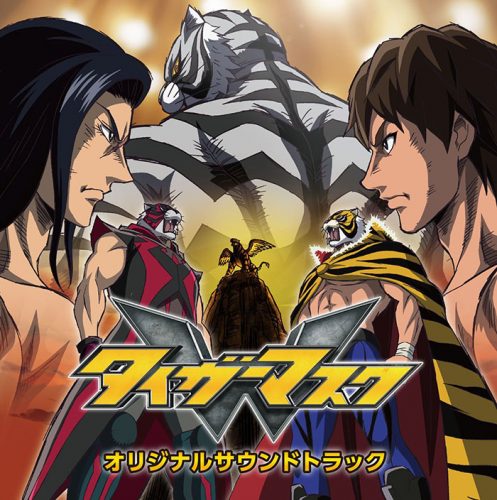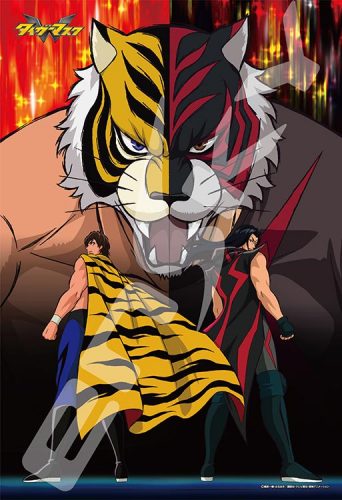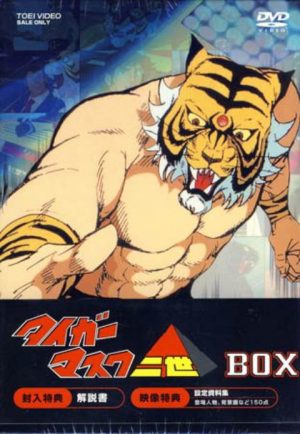
You Will Become a Tiger!
- Episodes : 38
- Genre : Sports, Action, Drama, Shounen
- Airing Date : Oct 2016 – Jul 2017
- Studios : Toei Animation
Contains Spoilers
Tiger Mask W Introduction and Story (Spoilers)
Tiger Mask W (with the W intended to be read as “double,” not as the letter “W”) is the sequel to the original 1969 series now taking place in modern times. The central characters are Naoto Azuma and Takuma Fujii, two aspiring young wrestlers training out of the Zipangu Gym. Three years prior to the series, Daisuke, their trainer and Takuma’s father accepts the challenge from the top dog of the dastardly Tiger’s Den, the Yellow Devil. After a severe beating that would require physical care for probably the rest of Daisuke’s life, Naoto and Takuma go their separate ways to train to defeat the Yellow Devil. Takuma joins the Tiger’s Den while Naoto seeks the tutelage of the first Yellow Devil from the original Tiger Mask series, Kentaro Takaoka (whose original voice actor, Ryouichi Tanaka, returns to the role).
After three years of hard training that meant life or death, Takuma becomes Tiger the Dark while Kentaro passes the mantle of Tiger Mask to Naoto (with the original Tiger Mask sharing his name). With both men without being aware of each other’s identities, they consequently become rivals in their paths for revenge. Not only does Tiger Mask have to eventually face Tiger the Dark as he seeks the Yellow Devil, he also must face his generation’s versions of the wrestlers from the original series such as Red Death Mask, Mr. Question, and the Miracles. However, he is not alone on his journey to the top as he is also aided by New Japan Pro Wrestling’s present roster that puts the likes of WWE’s John Cena and Roman Reigns to shame in terms of in-ring capabilities.
What You Liked About Tiger Mask W
Tiger Mask is a pop culture icon in not only in the world of anime and manga but also in the actual world of Japanese professional wrestling. Versions of Tiger Mask have been around for the past 35 years represented by numerous talented wrestlers such as Satoru Sayama and the late Mitsuharu Misawa. While the real Tiger Masks have been hits, it was inevitable to revisit his roots as an anime character.
Some elements from the original series are carried over, Tiger Mask W does a great job of being its own distinct series without requiring any exposure to the first series from nearly 50 years ago to enjoy it. Not only is it a story about professional wrestling, Tiger Mask W provides a human story about hard work, overcoming the odds, redemption, and valuing your friends and family.
Discussion Time
If you love wrestling whether it would be the drama oriented style you see in America, the high-flying acrobatics of Lucha Libre, or the sports emphatic Japanese style, this is the series for you. Due to the fact that it features some real-life Japanese wrestlers who are the hottest stars in New Japan, fans will probably get a kick out of this. Heck, even the real-life NJPW has caught on by having their own Tiger Mask W on their roster.
However, we cannot deny that the series can be a little ridiculous since it doesn’t represent professional wrestling being a work (work is a wrestling term meaning it’s all an act). So if you’re familiar with wrestling vocabulary, Tiger Mask W presents itself as kayfabe by trying to make you think wrestling is real, which works in an understandable way as we contextualize it in this review.

1. It Features Real-life NJPW wrestlers
Not only does this series have Tiger Mask competing for New Japan Pro Wrestling, but features its present contenders such as Tetsuya Naito, Hiroshi Tanahashi, NJPW president Yuji Nagata, and IWGP champion Kazuchika Okada. While the anime style portrays their looks in a more comedic tone by exaggerating their expressions and personalities, it is still fun to see art imitate life.
Naito’s bizarre gestures of holding his eye open with his fingers and how he presents himself as lazy is as entertaining in anime as it is in the real ring. Tanahashi’s energetic personality by telling the crowd he loves them along with his boyish charms are portrayed in this anime for wrestling fans to appreciate. However, Okada’s dark and embodying charisma is unfortunately toned down for the anime (if you’re familiar with his real personality, he doesn’t make it rain money that much as an anime character.
2. Fun Action
Since this is a wrestling anime, it is only natural to see a lot of action. A lot of basic moves you see in wrestling are presented in this anime such as the lariat, the drop kick or the abdominal stretch. For some of you long time WWE fans who are familiar with Undertaker’s Tombstone Piledriver, Tiger the Dark uses it as one of his signature moves but refers to it as the Darkness Driver as a reflection of his character. While you would never see it in American wrestling, there are instances where he does it from the ropes since it is common in Japanese wrestling to use such high-risk moves. American wrestling refrains from such moves due to injury risks and to prevent any bad influences it could have on children.
For Tiger Mask, he uses techniques taken from some previous real-life Tiger Masks such as the Rolling Sobat, the Tiger Bomb, and the Tiger Suplex. Eventually, he finds his own finishing move, the Tiger’s Fang, to guarantee a three count. As for the real-life wrestlers, you get to see Okada use his Rainmaker clothesline and Tanahashi’s High Fly Flow.
3. Inspired a Real-Life Tiger Mask W
Upon the premiere of this series, an actual Tiger Mask W and Tiger the Dark made their debuts in the ring of NJPW. The current man to take up the Tiger Mask legacy is Kota Ibushi, who has previously competed in the WWE’s NXT promotion. Just like in the anime, he wears the trademark mask and the black and blue trunks. You can even watch highlights of the real-life Tiger Mask W on YouTube as he faces the real-life Tiger the Dark (who is performed by ACH, an American wrestler of the independent Ring of Honor promotion). Some of what you see in that match shares some common features from episode 12 of the anime such as the use of the highflying acrobatics, kickboxing combinations, and head crushing slams.
1. No Legends or Real-Life Western Wrestlers Featured
While the previous Tiger Mask series featured famous Western icons such as Stan Hansen, Abdullah the Butcher, Classy Freddie Blassie, and Andre the Giant, no real-life Western wrestlers are at all featured in this installment. With the present Japanese contenders and champions being portrayed, it is only natural for some fans to assume that present day non-Japanese wrestlers would be animated. While it is undeniably unrealistic to expect the likes of present day WWE superstars such as Dave Bautista, Brock Lesnar, and Triple H, the series could have had NJPW’s hottest Western star, Kenny Omega.
In NJPW’s war against the Tiger’s Den, it would have been nice to see the talented Kenny Omega (who had an amazing match with Okada you can catch on YouTube and has been praised as one of the best matches in wrestling history) bring the fight to them. While there are Western wrestlers in this series, they are original characters for the series.
Last, with NJPW founder and pro wrestling legend Antonio Inoki being largely present in the two previous animes, he is nowhere to be seen or mentioned in Tiger Mask W. Considering how much Inoki contributed to Japanese wrestling and MMA (he fought Muhammad Ali to a draw in an actual fight in the 1970s) and how much of a role he played in the 1969 series and in Tiger Mask Nisei, it is rather tragic to see an icon not be given his due in context with this series. While we could speculate it is because Toei not getting the rights to Inoki’s likeliness, his lack of presence does leave a rather big hole.
2. Kayfabe
For some of you wrestling fans reading, you are likely aware of a video of a Q&A in South Carolina featuring two golden legends, Terry Funk and Harley Race. In that video, an emotional and passionate fan in attendance extends his thanks to the wrestlers present for putting their health at risk just to entertain the audience and ends it by screaming, “IT’S STILL REAL TO ME DAMMIT!” In a way, that saying applies to Tiger Mask W.
We all know professional wrestling is a work meaning that it’s all a performance, but a unique one that requires a high level of athleticism and conditioning. Nevertheless, wrestlers do get injured (some to the point of permanent paralysis such as with Hayabusa, Darren Drozdov, and The Dynamite Kid) and that is why fans still respect them and why people shouldn’t loosely say that wrestling is fake. In fact, Mitsuharu Misawa, the second man to wear the Tiger Mask mantle, died from an in-ring accident back in 2009. It does take a lot to go out there to put your bodies on the line to entertain a crowd while being on the road almost 24/7.
While the industry didn’t get around to classifying itself as sports entertainment towards the end of the nineties, up until that time, the business wanted audiences to believe it was real (with wrestlers going as far as assaulting reporters by putting them in headlocks whenever they were asked if wrestling was fake). Going back to the original Tiger Mask series that was broadcasted from 1969 to 1971, it was at a time when audiences were made to believe wrestling was real and creators were allowed to get away with certain things that would go as far as death in the ring. It was broadcasted not only during a time when it was presented as kayfabe but when Japanese audiences actually got heart attacks because of how violent some matches were, most notoriously between Freddie Blassie and Rikidozan.
Since Tiger Mask W is a direct sequel to a series that contains such extremities, it wouldn’t make sense to portray wrestling as a work in relation to how characters died in the ring during the events of the first series. Once you contextualize everything dating back to that installment, it is understandable as to why wrestling would be portrayed as a legitimate combat sport in Tiger Mask W.
3. Doesn’t Fully Show the Distinctions of Japanese Wrestling
Japanese wrestling is not only distinct from its rather MMA-like approach but with how hardcore it gets. While the WWE has your typical no DQ matches or Hell in the Cell every other Pay-Per-View event or so, the Japanese take it to a radical extreme. Instead of ropes, did you know that Japan has matches with barb wire on fire? Have you heard of matches where if there is no winner within a certain time limit, the ring explodes? Or did you know that they have bouts where the only way to win is to throw your opponent in a tank of piranhas? Unfortunately, Tiger Mask W does not have any of these insane gimmick matches.
Speaking of which, one episode of the original Tiger Mask series actually has an episode dedicated to throwing the opponent into a pool of piranhas! While Tiger Mask W does loosely have hardcore elements such as using tables, ladders, and chairs as weapons, they’re not central to the series. If there is one reason why portraying gimmick matches weren’t possible, New Japan in real-life is not known for such matches (NJPW is more popular for having a more MMA like approach with their matches) which are probably why the series doesn’t have them.
Final Thoughts
It is understandable that some audiences are going to be mixed in this series that our review has provided. It does appeal to a very niche audience who has a strong familiarity with both the original Tiger Mask series and to Japanese wrestling. If you come into this series with the exclusive exposure to American style wrestling that emphasizes more on in-ring soap operas, then this anime may be a good gateway to Japanese wrestling. If you come into this series with an understanding that the Japanese see wrestling as a sport as opposed to a drama, then you can appreciate the shoot fight aspects of it.
While many of you readers have probably never seen the original Tiger Mask series, fans of that series probably won’t initially like how W isn’t as dark as the old series. But when they can contextualize what has happened between now and then in society and the wrestling business, it is easy to understand why Tiger Mask W presents itself more optimistic and upbeat. The series ends on a high note and hopefully, a sequel can happen. In the meantime, while the anime has hung up its boots, we can tune in on the Internet for videos of the real Tiger Mask W as well as matches with Naito, Tanahashi, and Okada.
Recommended Post
Tiger Mask W - Fall 2016, Winter 2017, & Spring 2017
Recommended Post
Top 5 Wrestling Anime [Best Recommendations]
Recommended Post
The Sport of Pro Wrestling As Seen in Tiger Mask W
Recommended Post



